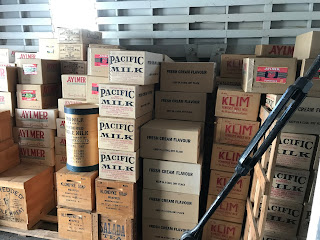So come along with me and see some wild animals!
A few days later, we visited the SS Klondike. It is a riverboat that went up and down the Yukon River from 1929-1955. It is made of Douglas Fir (a readily available resource), burned it too---one cord going down the river (with the current), three cords up the river (against the current). She mainly carried ore because of the gold rush, and then they found silver, so she carried that, too. Once the Alaska Highway came through, trucks were the preferred mode of transport, so she was put in the shipyard, drydocked, and became an historic site.
Her draft was only three feet/1 meter of water, and when she got stranded, it was usually a sandbar. The paddle was in the back, so she was a "sternwheeler" (back wheeler); which was good because any debris passing by was broken up by the bow of the ship instead.
She had a crew of 23 and hauled upwards of 64 passengers, but mostly it was ore. She ran to Dawson (or Dawson City) which up until 1959 was the capital of the Yukon, and back down to Whitehorse. The trip up was 1.5 days and the trip back was 3 days. The entire season of the riverboat was 4 months in the year.
The fire man stoked the furnace with wood. They only carried what they needed to get from Point A to Point B. The main job of the boat was ore; and ore meant profit. So every spare inch was for that purpose. The fire man put a log in every 30 seconds. He worked 4 hours on, 8 hours off. It was the most grueling job on the boat. This is the front of the firebox (at the bow of the boat)
the back (a giant cauldron, basically)
the engine room at the back of the boat (stern)
So, now that we've left Whitehorse, we head downriver to pick up the ore. This is what you get:
This is galena, a lead ore containing significant amounts of silver. They hauled bags of this stuff, weighing about 25 pounds (4 on a trolley). They were pretty "cut", wouldn't you say??
This man is demonstrating for us how it was hauled
each of these bags would contain 25 pounds of ore; they would be stacked along the side of the ship,
as much as it would hold.
This is the berthing for the general crew. They slept behind the engine room; very noisy, very hot.
stores for the crew and passengers
There was also berthing for first and second class passengers. They had a dining area, too. First class passengers had their own kitchen and dining hall.
Second class passengers had their own kitchen as well. They, however, had to eat on the deck.
Along with passengers and crew, ore and logs for fuel, food and other what-nots, the boat carried mail and luggage for those who decided to move to Whitehorse.
actual mail bags from that time
(hope there is not still mail in it)!
It was a great guided tour and reasonably priced ($6.10CD, $4.50 USD). Our guide was very knowledgeable, and today was the first day of the season. We had an excellent weather day, even if it was a little chilly (about 56 degrees).
Thanks for coming with us. Hope to see you soon! 😉


















No comments:
Post a Comment